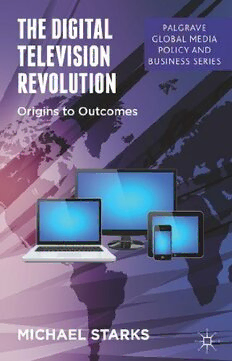
The Digital Television Revolution: Origins to Outcomes PDF
Preview The Digital Television Revolution: Origins to Outcomes
The Digital Television Revolution PalgraveGlobalMediaPolicyandBusiness Series Editors: Professor Petros Iosifidis, Professor Jeanette Steemers and ProfessorGeraldSussman EditorialBoard:SandraBraman,PeterDahlgren,TerryFlew,CharlesFombad, Manuel Alejandro Guerrero, Alison Harcourt, Robin Mansell, Richard Maxwell, Toby Miller, Zizi Papacharissi, Stylianos Papathanassopoulos, CarolinePauwels,RobertPicard,KiranPrasad,MarcRaboy,ChangYongSon, MiklosSuksod,KentonT.Wilkinson,SugminYoun This innovative series examines the wider social, political, economic and technologicalchangesarisingfromtheglobalizationofthemediaandcommu- nications industries and assesses their impact on matters of business practice, regulation and policy. Considering media convergence, industry concentration and new communications practices, the series makes reference to the paradig- maticshiftfromasystembasedonnationaldecision-makingandthetraditions of public service in broadcast and telecommunications delivery to one that is demarcatedbycommercialization,privatizationandmonopolization.Bearingin mind this shift, and based on a multi-disciplinary approach, the series tackles threekeyquestions:Towhatextentdonewmediadevelopmentsrequirechanges in regulatory philosophy and objectives? To what extent do new technologies and changing media consumption require changes in business practices and models? And to what extent does privatization alter the creative freedom and publicaccountabilityofmediaenterprises? KarenDonders,CarolinePauwelsandJanLoisen(editors) PRIVATETELEVISIONINWESTERNEUROPE Content,Markets,Policies MichaelStarks THEDIGITALTELEVISIONREVOLUTION OriginstoOutcomes PalgraveGlobalMediaPolicyandBusiness SeriesStandingOrderISBN978–1–137–27329–1(hardback) (outsideNorthAmericaonly) You can receive future titles in this series as they are published by placing a standing order. Please contact your bookseller or, in case of difficulty, write to usattheaddressbelowwithyournameandaddress,thetitleoftheseriesand theISBNquotedabove. Customer Services Department, Macmillan Distribution Ltd, Houndmills, Basingstoke,HampshireRG216XS,England The Digital Television Revolution Origins to Outcomes Michael Starks UniversityofOxford ©MichaelStarks2013 Allrightsreserved.Noreproduction,copyortransmissionofthis publicationmaybemadewithoutwrittenpermission. Noportionofthispublicationmaybereproduced,copiedortransmitted savewithwrittenpermissionorinaccordancewiththeprovisionsofthe Copyright,DesignsandPatentsAct1988,orunderthetermsofanylicence permittinglimitedcopyingissuedbytheCopyrightLicensingAgency, SaffronHouse,6–10KirbyStreet,LondonEC1N8TS. Anypersonwhodoesanyunauthorizedactinrelationtothispublication maybeliabletocriminalprosecutionandcivilclaimsfordamages. Theauthorhasassertedhisrighttobeidentifiedastheauthorofthiswork inaccordancewiththeCopyright,DesignsandPatentsAct1988. Firstpublished2013by PALGRAVEMACMILLAN PalgraveMacmillanintheUKisanimprintofMacmillanPublishersLimited, registeredinEngland,companynumber785998,ofHoundmills,Basingstoke, HampshireRG216XS. PalgraveMacmillanintheUSisadivisionofStMartin’sPressLLC, 175FifthAvenue,NewYork,NY10010. PalgraveMacmillanistheglobalacademicimprintoftheabovecompanies andhascompaniesandrepresentativesthroughouttheworld. Palgrave®andMacmillan®areregisteredtrademarksintheUnitedStates, theUnitedKingdom,Europeandothercountries. ISBN978–1–137–27334–5 Thisbookisprintedonpapersuitableforrecyclingandmadefromfully managedandsustainedforestsources.Logging,pulpingandmanufacturing processesareexpectedtoconformtotheenvironmentalregulationsofthe countryoforigin. AcataloguerecordforthisbookisavailablefromtheBritishLibrary. AcatalogrecordforthisbookisavailablefromtheLibraryofCongress. To Sue, Mary and Jack This page intentionally left blank Contents ListofIllustrations viii Preface ix Acknowledgements xiv ListofAcronymsandAbbreviations xvi Introduction 1 Part I BirthandDevelopment 1 TheImpetusforDigitalTelevision 13 2 TheDigitalTerrestrialPioneers 32 3 TheUK’sDigitalTransition 55 4 Europe’sCoordinatedTimetable 75 5 TheWiderGlobalPicture 94 Part II ShapingtheOutcomes 6 HowtoSwitchOffAnalogueTV 115 7 ConvergedCommunications 135 8 Cross-MediaRegulation? 158 9 PublicServiceDigitalMedia 180 10 TheDemocraticDividend 202 InConclusion 221 References 226 Index 235 vii Illustrations Figures I.1 TheUK’suseofUHFspectrumforanaloguetelevision broadcasting 6 3.1 TheUK’soriginalplanforspectrumrelease 67 4.1 EmergingpatternofUHFspectrumuseinEurope 93 5.1 Long-termgoalforUHFspectrumuseacrosstheglobe? 111 Tables I.1 CountriescompletingdigitalTVswitchoverbyendof 2012 9 3.1 Transitiondurationforcountriescompletingswitchover byendof2012 57 viii Preface InOctober2012theUnitedKingdom(UK)completedtheswitch-offof its last analogue television transmitters. A couple of months earlier, at the 2012 London Olympics, the BBC, which had only two TV chan- nels back in the five-channel analogue era, showed just what could be donewithdigitaltechnology.MainstreamOlympiceventswerecarried on BBC One and BBC Three and in high-definition. Digital terrestrial viewers could receive two additional channels of broadcaster-selected eventsonFreeview.Thenupto24furtherBBCOlympicchannelsoffered live coverage of individual sports – across the alphabet from Archery, Badminton and Basketball to Tennis, Volleyball and Weightlifting – so that viewers could select their own events. Cable and satellite house- holds could find these extra services on their main TV sets using the Electronic Guide; terrestrial TV households needed to access them on their computers. Away from home, people could watch the Olympics on their mobile phones. The opening and closing ceremonies and the men’s 100m final were also broadcast live in 3D. A new television era hadarrived. The shift from analogue to digital television involves more than an enlargement of viewer choice. It has been accompanied by the convergence of the broadcasting, computer and telecommunications industries, now all based on digital technology, which facilitates link- ages, including content transfer, between them. This has led to the distribution of television via broadband and mobile telecommunica- tions. It has blurred the interface between television and the Internet, bringing On-Demand TV to the computer and YouTube videos to the ‘Connected TV set’. Cable and satellite broadcasters have multiplied thechoicesofferedbytheirvideosupermarkets.Over-the-airterrestrial television has been able to expand its output dramatically, while at the same time releasing broadcasting spectrum to the hungry world of telecommunications. Analoguetelevisionwasmainlyviewedsimultaneouslybymassaudi- ences conforming to timetables set by the broadcasters. Digital televi- sion, with digital recording devices and broadband connections, offers On-Demand and self-scheduling options. While large audiences still ix
